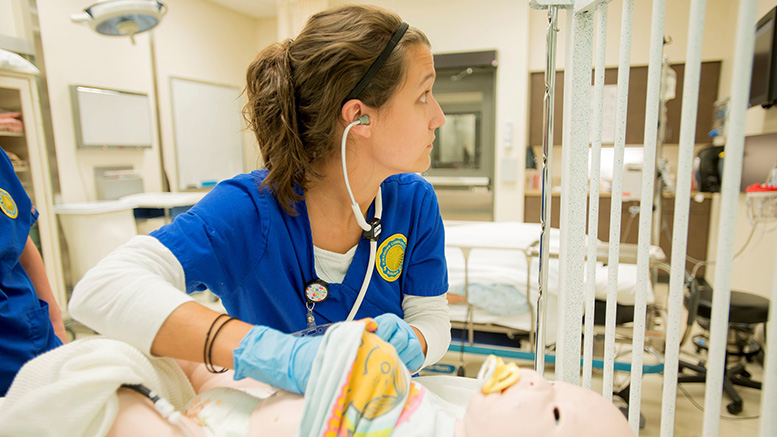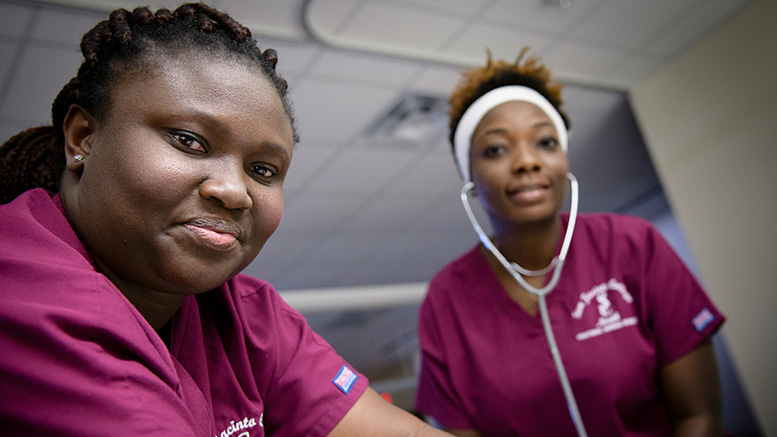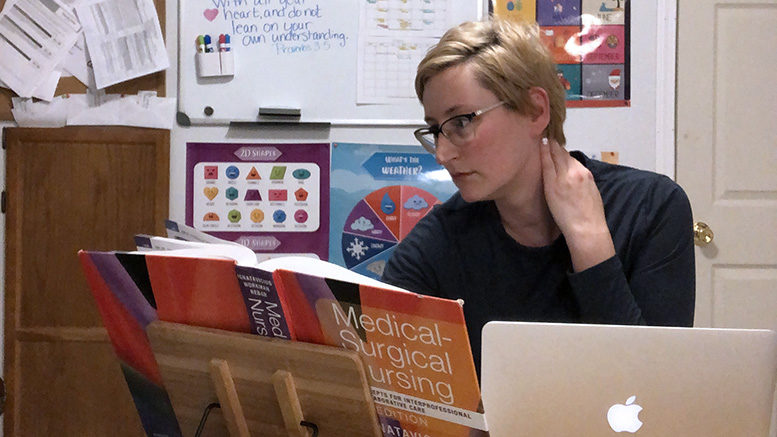The COVID-19 pandemic has led to an all-hands-on-deck moment for nurses and other allied health workers. But community college students hoping to join their ranks are facing challenges in completing their credentials as a result of policies pertaining to the pandemic that have prompted the cancelation or scaling back of clinical experiences they must finish.
States, schools and healthcare institutions are trying to be creative with online clinical offerings, although opportunities tend to differ by location and programs in terms of how much students can complete.
A coalition of 10 nursing organizations has issued a joint statement on meeting clinical-hour requirements in the current environment. It encourages partnerships between nursing education and practice agencies, requesting that students not be categorized as “visitors” to healthcare facilities but rather as personnel. The statement notes the potential for a “teachable moment” around issues related to facing a pandemic.
An accompanying policy brief from the coalition notes that, to the extent pre-licensure students have their clinicals discontinued, “all nursing students will have a deficit in their education, (will be) unable to meet their program requirements and will not be eligible for graduation at a time when RNs (registered nurses) and PN/VNs (practical nurses/vocational nurses) are needed in the healthcare system.”
The brief proposes that facilities use pre-licensure students to “augment and support” nursing services. They could be hired as full- or part-time student nurses, who would be paid and receive credit, while enrolled in a state board of nursing approved pre-licensure program or its equivalent.
Encouraging flexibility, innovation
Beverly Malone, CEO of the National League for Nursing, one of the signatories, says she’s seen innovation and creativity from nursing programs and their partners, as well as flexibility from accreditors during these unusual times. She’s noticed “a new vision for how nursing can be more agile, more flexible and more innovative through things like simulation,” she says. “Do we really need to do all of that? Could we do some things in simulation, and do it online?”
Accreditors are being appropriately flexible, Malone believes, allowing innovation up to a point.
“Someone has to have that boundary of saying, ‘You can go this far, but you can’t go beyond that because then you are going to get an (educational) product that’s not going to deliver quality,’” she says. “It can’t be one-size-fits-all. Some people may be doing 40 percent simulation. Other people may say, ‘The way our curriculum is, we can’t do that.’”
Related article: From the front lines to the classrooms and back
The Organization for Associate Degree Nursing, another of the 10 signatories and an affiliated council of the American Association of Community Colleges, has definitely noticed a move toward simulation. CEO Donna Meyer says each state has different standards governing use of simulation, so OADN has been encouraging programs to reach out to state boards of nursing and accrediting bodies.
“All throughout these programs, from the very beginning, students are taught infectious disease protocol, to make sure they understand personal protection equipment,” Meyer says. “In some ways, they really could help in the hospital setting. For them to be excluded is very challenging right now. We’ve encouraged our members to try to communicate with clinical facilities and find out where they could still be of help.”
A new environment
The responses of facilities have varied, in part, driven by state board regulations. Nursing and allied health programs at community colleges have faced challenges in California, says Sharon Goldfarb, dean of health sciences at the College of Marin, which has lost all but two of its hospital partnerships for the spring — and even those reduced the number of students by half and totally restricted certain units.
“It really is a disaster,” she says, noting that although the state nursing board recently relaxed its requirements for clinical hours from 75 percent to 50 percent direct patient care, that still did not suffice once the shutdown occurred.
“A lot of (students) are saying, ‘We’ll try the summer, we’ll try next fall,’ but there’s no guarantee,” she says.
In mid-April, Goldfarb was aware of only two schools that have a board-approved plan allowing students to complete their nursing programs on schedule. One glimmer of hope has been a state health corps program for which most Marin students have signed up, designed to bring students onto the frontlines of battling the pandemic.
“We don’t know whether it will count for clinical (hours), whether they will get called in, whether they will be placed, what they will do,” she says. “There’s also an issue of equity: A student with a compromised immune system, or who is the only caretaker of elderly patients … can’t go and be frontline workers because the risk is too great.”
Volunteering for experience
Krista Alborg, a nursing student at Marin who hopes to graduate in May, is among those volunteering at COVID-19 drive-through testing sites.
“Most of us were seven weeks away from graduating when all hell broke loose,” she says. “If everything continues perfectly between now and the next four weeks, we should be able to graduate. It’s so fluid right now.”
Alborg says she’s grateful for the opportunity provided by the testing sites.
“To lose the preceptorship was sad,” she says. “To go from that to the frontlines of testing COVID patients was pretty scary at first. But with proper PPE (personal protection equipment), it’s really satisfying to be able to take care of patients and do what we were trained to do … and take some of the stress off healthcare workers who are stretched so thin in our community.”
A partnership for solutions
Students at Kirkwood Community College in Cedar Rapids, Iowa, have lost their clinical opportunities at most hospitals but still have been able to continue final semester preceptorships in person at the University of Iowa Hospitals & Clinics (UIHC).
UIHC, University of Iowa College of Nursing and Kirkwood have partnered to develop a joint statement to nursing leadership organizations in Iowa to advocate for practice-education partnerships to further support student completion and urge hospitals to reopen to students.

Kathy Dolter, dean of nursing at Kirkwood, says her school has tried to work with other hospitals to allow students who they plan to hire to start in the summer to complete their preceptorships based on that understanding. As of mid-April, 11 students were given this opportunity. Dolter expects that will increase.
“We are going to be able to get the majority of our final semester students through in the normal time frame,” she says. “Then, as the hospitals reopen, they will complete their preceptorship hours with our usual partners as they’re able to.”
Although the Iowa Board of Nursing has allowed simulation as a substitute for up to 100 percent of hours, Dolter notes that evidence for simulation as a replacement for clinicals is based on research with computerized, high-fidelity mannequins, which Kirkwood can’t offer because its simulation centers are closed.
“Our faculty voted that we did not want to substitute non-evidence-based strategies and instead voted to reduce clinical hours to 75 percent of usual,” she says. “But everybody has to do what they think is right.”
Mannequins in the guest room
Other schools are allowing for remote simulation with inert mannequins. At Ivy Tech Community College in Indiana, nursing instructor Linda Marie Deckert of the Terre Haute Campus has two mannequins in her guest room, and she also brought home supplies used to teach certain skillsets.
Using Zoom, Deckert runs through scenarios with students, who use household objects to demonstrate what they would be simulating with the mannequins. If they’re simulating an injection, for example, they might use a lemon or a lime.
“It’s different just because we’re not there to guide their hands,” Deckert says. “It’s not really that much different because of the audio and video. We can see what they’re doing in real-time. When they return-demonstrate, if there’s an issue, we can correct them.”
The mannequins aren’t entirely necessary for educational purposes, says Kim Cooper, dean of nursing at Ivy Tech.
“A lot of it is hand placement: How do you hold the needle? Where do you put that catheter?” she says.
If the student needs to perform an assessment involving lung sounds, or picking up on other cues, “We are acting things out,” Deckert says. “At the end of the scenario, we have questions such as, ‘If I hadn’t done such-and-such, what would have happened with the patient?’ Or, ‘If there were sutures missing when you did that dressing change, what would have been different?’”
Ivy Tech acted quickly when it became apparent that physical locations for clinicals would be shut down, says Jewel Diller, assistant vice president of nursing.
“Nursing has more latitude than other programs,” she says. “We feel confident that finishing up in a virtual sense is not going to be an issue for them.”
With test-taking sites mostly shut down, graduates will be able to become licensed for 90 days, with 30-day renewals available for as long as the COVID-19 outbreak continues.
“We’re encouraging students not to wait to take their boards if there’s availability,” Diller says. “Data suggest that folks who do not test within the first six weeks (after graduation) do not do as well.”
Other healthcare-related programs
For other allied health programs, Ivy Tech has needed to evaluate next steps per program, says Lacie Couzin, dean of the school of health sciences at the Sellersburg Campus. She’s been meeting with curriculum committees and using accreditor guidelines to determine what’s possible.
About two-thirds of physical therapist assistants are on track to graduate, but the others have not met the entry-level standard as required by the accreditor. And since physical therapist assistants cannot practice remotely, they will be considered high priority once they can come back on site, Couzin says.
Some medical assisting students have met their hours because Ivy Tech’s curriculum committee temporarily brought its requirements down to what accreditors mandate — which many students already had finished. Respiratory students will be able to get a student license prior to taking board certification exams.
“We’re going to have a lot of incompletes to do over the summer,” Couzin says. “The thing I’m most proud of is my faculty. They are not accustomed to doing remote delivery, and they have embraced it as well as they possibly could.”
Some field experience available
Glen Oaks Community College in Centreville, Michigan, has converted all nursing students to 100 percent virtual simulation after the state nursing board approved such arrangements, says Sara Birch, director of nursing. Faculty have created virtual simulations and case studies to meet clinical requirements “which, of course, is a huge satisfaction for our students because they’re going to graduate on time,” she says.
Nurse aides at Glen Oaks will be able to complete on time, if they so choose, because one of the nursing homes with which the school partners is still accepting them on site, says Carol Naccarato, director of allied health and medical assisting. Testing sites are closed, but the licensing board has extended the period during which students can work anyway, she says.
Phlebotomy students already had finished their practicums before the COVID shutdowns, and medical administrative specialists had their skills approvals signed off remotely, Naccarato says.
Medical assisting students are a different issue because the accrediting body has not relaxed requirements to check off skills in person.
“We are going to have to give them an incomplete,” she says. “And as soon as we can, we will bring them back face to face.”
Seeking flexibility
San Jacinto College in Houston has been discussing with its state board of nursing to try to adjust guidelines regarding clinicals so students can finish on time, says Teddy Farias, dean of health and natural sciences.
“We’ve been working with the college leadership and employer partners to see what we can do to have students complete that mandatory part,” he says. “We’re doing everything we can virtual or simulated.”
Nursing and allied health instructors have been working innovatively to get everything loaded online, including virtually simulated clinicals for one of the campuses, Farias says.
“If their accrediting body is flexible on what we can do for clinicals, we may even have a workaround or suitable alternative for that,” he says.

At Rowan-Cabarrus Community College in Salisbury, North Carolina, senior nursing students had completed in-person requirements in the clinical sites, says Wendy Barnhardt, dean of health and education programs. To ensure that they finish, the college is using the maximum allowable simulation, which is not the norm, she says. And the state has implemented a policy allowing graduate nurses to work under the direction of an RN prior to taking the licensing exam.
Radiography students were to able to complete their competencies the week before the COVID shutdowns, Barnhardt says, but occupational therapy and physical therapy assistant students were in the middle of clinicals or labs and are unable to return.
“We’re hoping they can finish in the summer, but that rides on when they let the students back in,” she says.
Dolter at Kirkwood expresses the universal hope that students of all types are allowed back in as soon as possible to finish clinicals and take exams.
“Every hospital has to do what they see the need for at the present time,” she says. “But if you shut off the pipeline of nursing students, that’s the pipeline of graduates, which has a huge impact on patient safety because there’s already a shortage — and then we’re adding to the shortage because of the pandemic.”

